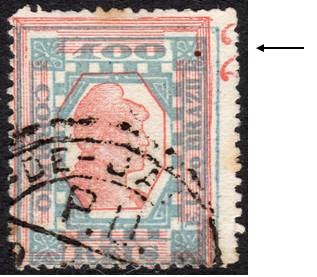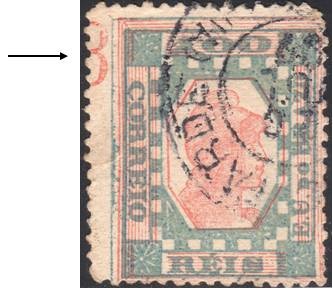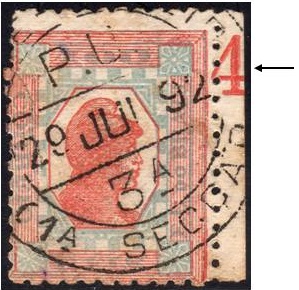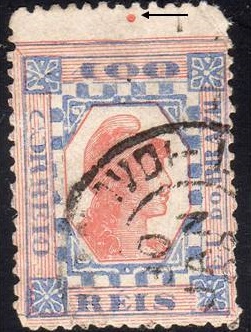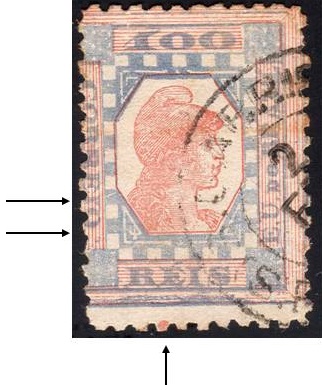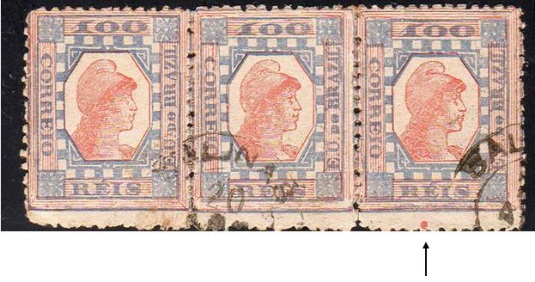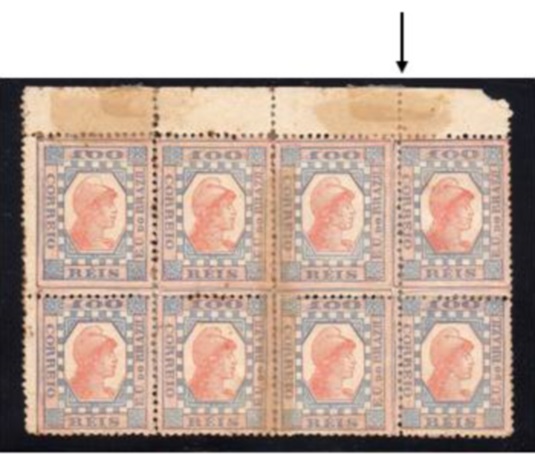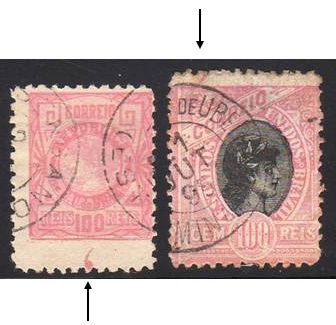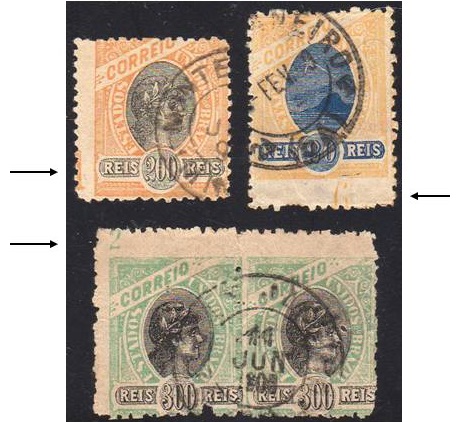Tintureiro Marginal Markings
By Ken Deaver
The following article was published in the July-Third Quarter 2012 issue of The Bull's Eyes (Volume 43, Number 3, Whole Number 170).
BACKGROUND
The Tintureiro issue of 1891 (Scott #109, RHM #79) was the first bi-color stamp locally printed in Brazil. It was produced at the Mint with letterpress (typographic) printing. Printing of the stamp required two plates: one to print the blue elements (frame, text, ornamentation), and the other for the red elements (vignette of Lady Liberty and numerous fine lines). The issue was printed to very loose standards resulting in hundreds of small printing faults making Tintureiros a favorite among devotees of fly-specking.
Tintureiros were printed in sheets of 100 stamps (10 x 10). The blue plate (frame, text, ornamentation) was printed first, and then the sheets were printed a second time using the red plate. A few stamps with sheet margins display marginal markings.
Two kinds of marginal markings have been described. The first has a numeral printed in red in the vertical margin on the top left or top right corner of the sheet. The second consists of a single red dot on the top or bottom horizontal margin. The following article describes these marginal markings. Advice and comment are sought from other Tintureiro collectors.
NUMERALS
Size and Location
Bezerra and Ribeiro (1996: 23, 29, 39-40) describe the numerals as 6 mm in height and with the odd numerals (1 or 3) occurring on the left sheet margin while the even numerals (2 or 4) are found on the right margin. Examples in the present collection vary from 5.80 mm to 6.55 mm in height. The difference between the shortest and tallest of any numeral (0.7 mm) can be attributed to the normal variation with typographic printing rather than distinctive types.
The numerals occur only on the red plate and are immediately lateral (left or right) of the thin parallel red lines and the thin blue border line that mark the edges of the corner stamp (Figures 1-3). The closest point on the numeral to the outside red line is 0.42 to 1.1 mm. The tops of the numerals are just slightly below the level of the top horizontal red line. The bottom of the numerals is just below the level of the top horizontal red line of the octagon. Again the very small differences in position for examples of a given numeral are well within the variation expected for typographic printing.
Rarity
Marginal red numerals are not common. The RMH catalog lists them as "79S" and values them at 10 times the price of a normal unused stamp or 183 times the value of a used stamp. Bezerra and Ribeiro (1996:40) state they only found 16 of the marginal numerals in all the collections they examined. However they feel that the scarcity is largely due to damage by the perforations.
In reality, their estimate of rarity is too conservative, but their caution about perforation damage is well founded. The present collection includes 24 examples of marginal numerals and most medium to large Tintureiro collections contain a handful of examples suggesting an extant population numbering in the hundreds. However virtually all examples show damage to the numerals from the perforations. In many cases the numeral has been reduced to a couple of red bulges or projections and the perforations have eaten away the main body of the numeral, sometimes making it difficult to determine if the numeral was a "2" or a "4".
Some numerals are more common than others. The numerals "3" or "4" are the most common, each with nine examples in the present collection. The numeral "2" is slightly less common with six examples.
Bezerra and Ribeiro (1996:39) note that one example of the numeral "1" is known, and at least one stamp claiming to have a "1" sold in the last few years, but even large collections seem to lack any examples. Bezerra and Ribeiro (1996:29) note that the long thin shape of the numeral "1" makes it particularly susceptible to obliteration by the perforations. However several Brazilian authorities and dealers question the existence of this numeral. Other long time collectors of Brazilian stamps have suggested that there was no numeral on the first plate (or printing) and the numerals 2, 3 and 4 indicated subsequent printings.
Bezerra and Ribeiro (1996:40) state that the numeral "3" can be found on either the left or right sheet margin, but add that it is far more common on the left side. Again large collections fail to support the existence of the numeral "3" on the right side. It is possible that heavy perforation damage to a "2" or "4" on the right side led to misidentification as a "3".
Colors, Paper Type and Perforations
Margin numerals do not occur in all colors known for Tintureiros. All examples occur on stamps with a blue to greenish blue frame (RHM = 79 to 79b) and red vignette. Due to mixing of inks Tintureiros occur with frames in every possible shade from blue to greenish blue. A few examples of margin numerals appear closer to a blue frame, but the majority is closer to greenish blue. No margin numerals are reported with the ultramarine frames (RHM = 79a) or the carmine vignettes (RHM = 79c).
All examples of margin numerals in the present collection are printed on paper type E and display a strong horizontal web. This paper type is equivalent to Napier's third printing (Meyer 1943:208).
Margin numerals occur on stamps with coarse (11 - 11.5), fine (12.5 - 14) and mixed (11.5 x 13.5 - 14) perforations. By 1890 (before Tintureiros were issued) the Mint had several perforating machines and could produce perforation of 11 to 14 (Bezerra and Ribeiro 1996:24). Perforating is completely independent of the printing process, and there is no correlation between particular perforation gauges and color or paper type. Fine perforations (13 - 14) are the most common on stamps with marginal numerals as they are on inverts, tete-beches and normal stamps.
Postmarks
Virtually all stamps with marginal numerals are used. Many of the cancellations are sufficiently complete to identify date and city of use. The dates on the postmarks indicate a rather narrow period of use. Sixteen of the twenty-four margin numerals in the present collection have readable dates, and they range from 7 May 1892 to 22 Sept. 1892, a brief 4.5 month period of use out of the 2.5 years that Tintureiros were printed. The numerals are not arranged chronologically. The earliest date (7 May) is on a stamp with the numeral "4" and the next to last date (23 Aug.) is on a stamp with the numeral "2".
The cities of origin on the cancellations indicate that margin numerals were widely used and not concentrated in a single area. Five cities in Rio de Janeiro state are represented (Nova Friburgo, Petropolis, S. Fidelis, Cordeiros and Rio de janeiro). In addition five other states appear: Minas Gerais (Tamandua, Ponte Nova, S. Joao Evangelista, S. José D'El Rey), Bahia (Carinhanha), Ceara, Parana (Antonina) and Sao Paulo (Estacao da Luz). This diversity stands in sharp contrast to the limited period of use. Although marginal numerals were short lived, they seem to have been widely used.
Faults and Plating
A number of printing faults can be found on stamps with marginal numerals. Included are small breaks in the thin red lines, minor white dots and larger blotches or smears. Most faults are result of inadequate or excessive/runny inking of the plates. All of these faults are relatively common on Tintureiros and none is restricted to stamps with marginal numerals. No specific "type" of marginal numerals has been identified based on printing faults.
All marginal numerals occur in positions 1 or 10 on the sheet of 100 stamps. Stamp with the numeral "3" and "1" (if it exists) occur in position 1 on the top left hand corner of the sheet. Stamps with the numerals "2" and "4" occur in position 10 on the top right corner of the sheet. It is important to note that the vast majority of stamps in position 1 and 10 do not have marginal numerals. Marginal numerals occur only in position 1 or 10, but very few stamps from these upper corner positions have any trace of a numeral.
RED DOTS
Size and Location
The second kind of marginal marking consists of a small red dot in the upper or lower sheet margin (Figure 4). Bezerra and Ribeiro (1996:28) mention
The red dots occur at two distances from the closest red line. Just over half (n = 7) range between 1.38 - 1.5 mm with a mean distance of 1.43 mm. The others (n = 5) range between 2.37 and 2.52 mm with a mean distance of 2.46 mm. The bimodal pattern suggests there are two types based on distance between the red dot and the closest red line.
Although the distance into the top or bottom margin presents as two discrete and constant groups, the left/right position within the margin is endlessly variable. The red dots "wander" from the left side to the right side of the stamp. They may occur anywhere in the top or bottom margin from 0.5 mm left or the left rosette all the way across the stamp and as far right as the right edge of the right rosette. In the present collection no position occurs on more than two stamps and most stamps represent unique locations. Consequently there is insufficient patterning to indicate multiple types based on left/right location.
Rarity
The RHM catalog does not list or value the marginal dots, but they definitely are rare. There are twelve in the present collection, half the number of the marginal numerals. They are smaller and less prominent than the numerals and are probably missed when examining Tintureiros. The dots are small and prone to near obliteration by a single well place perforation. They only are seen on stamps where there is nearly 2 mm of margin.
Colors, Paper Types and Perforations
All marginal red dots occur on ultra/red stamps. A few occur on the gray or charcoal subtypes of ultramarine, but no marginal dots are known on blue, greenish blue or carmine stamps.
All of the marginal dots occur on Bezerra and Ribeiro's paper types F and G. This is equivalent to Napier's fourth printing (Meyer 1943:208). The dots do not occur on any of the earlier paper types (A-E). There is no apparent correlation between paper type and dot diameter or location.
The marginal dots occur on stamps with fine (12.5 - 14), coarse (11 - 11.5), and mixed perforations. As with the marginal numerals the perforation process follows and is independent from the printing stage so no correlations would be expected.
Postmarks
All of the stamps with marginal red dots are cancelled except a block of eight. Eight of the examples have readable dates. Seven of the eight readable dates indicate a brief three month (30 Jan. – 20 Apr.1893) period of use. A single date (10 Sept.1892) may indicate an earlier use, but the apparent red dot on this stamp is incomplete and partially obliterated by perforations. It is possible that the red mark is not a marginal red dot, but rather a random red smear and not related to the process that produced the marginal red dots. There is no clear relationship between date of use and particular attributes (diameter, location) of the red dots.
The cities of origin on the postmarks are varied and represent large and small cities. The following cities are readable on the postmarks: Campos, Pelotas, Jussiape, Rio de Janeiro and Salinas. The cancellations indicate that sheets with marginal red dots were dispensed at a number of post offices across central and southern Brazil. As with the marginal numerals the postmarks on stamps with marginal red dots indicate a very narrow period of use over a broad area.
Faults and Plating
As with marginal numerals a wide variety of printing faults occur on stamps with marginal red dots. Included are small breaks in the thin red lines, absence of a period after the "U" of "E.U.", and many blotches and smears, the result of over inking the ultramarine plate. All of these are common on Tintureiros, and each occurs on a single example with a red dot. They appear unrelated to the marginal dot.
There is, however one set of paired printing faults that occurs on three of the twelve stamps with marginal dots and does not appear on any other Tintureiros in the collection. The faults include a thin isosceles white triangle on the bottom of the bottom left triangle and a diagonal white scratch through the "I" of "CORREIO" and the blue square immediately to the right (Figure 5). This pair of faults doesn't occur on all stamps with marginal dots, but neither fault in the pair occurs on any normal Tintureiro. The red dots are all located just left of the center of the stamps with this pair of faults. These paired faults on the blue/ultramarine plate may be defining attributes along with the dots on the red plate for a unique type on marginal dots, but the sample size is too small for final designation of types.
By definition, all stamps with marginal red dots occur on the upper or lower sheet margin. No examples in this collection occur on corner stamps. Therefore all marginal red dots in this collection appear in sheet position 2 to 9 or 92 to 99. A strip of three stamps in this collection has a bottom left corner on the left hand stamp and a marginal dot on the right hand stamp in position 93 (Figure 6). This is also one of the three paired faults mentioned earlier. A block of eight Tintureiros has the top left sheet corner and a marginal red dot four stamps to the right in position 04 (Figure 7). All other marginal red dots are on single stamps where the sheet position cannot be determined beyond saying they occur on the top or bottom row of the sheet.
PURPOSE OF MARGINAL MARKINGS
Bezerra and Ribeiro (1996:29) describe the marginal numeral and state, "As they are printed in red, it seems obvious to us that they indicate the number of the printing plate". Rubel (2001:9) and the RHM Catalog also describe them as plate numbers. Since the numerals always occur in specific locations and sizes it is a reasonable assumption that they were a part of the red plate at least for a few months. However it is not clear what purpose the numerals served.
Marginal plate numerals can serve several functions:
- Control numbers (or check marks) - consisting of a number intended as a security measure to limit pilferage (Williams 1990:102, 141), Youngblood (200:44);
- Tally marks - any number or mark used to count the number of sheets printed with a particular plate;
- Identification marks - numbers, dots or any marginal mark intended to identify sheets printed in a particular way or with a particular experimental printing process. A recent article by Robinson (2011:247) describes a small number of sheets of U.S. definitives and postage due issues printed with a marginal "O" and several marginal dots to brand sheets printed only briefly using an experimental process called "oil tempered plates".
The marginal numerals on Tintureiros present a similar situation where the numerals were printed only briefly and on a single type of paper. They may have been intended to identify sheets printed with a slightly different process.
The purpose of the marginal red dots is even more obscure. In discussing the marginal dots, Bezerra and Ribeiro (1996:29) say, "The reason for these is still not clear". Marginal dots are usually assumed to be guide or registrations marks intended to assure proper registration of the plates. However the marginal dots on Tintureiros could not have served this purpose for two reasons: 1. The dots wander, appearing anywhere from the left to the right side of the top or bottom margin. They would not be very useful as registration or guide marks for aligning the two plates when their position is so variable; and 2. On Tintureiros the blue plate was printed first followed by the red plate. The marginal dots were printed with the red plate and would not have been visible until after both plates had been printed. Registration marks would not have been very useful if they had not been visible until after the plates had been aligned and both had been printed.
Another "function" has been proposed in casual conversations. The dots look something like the heads of tin tacks used to attach the cliché to the plate backing. If this is the origin of the marginal dots then they are an unintended by-product of the printing process and served no purpose in themselves.
The marginal dots are similar to the marginal numerals. Both occur on stamps with a very narrow range of colors and papers, and for a brief period of use. They may have served a number of functions, but their brief period of use suggests that the intended function(s) was either not essential or was tested for a brief period and then discontinued.
MARGINAL MARKINGS ON OTHER REPUBLICAN ISSUES
Napier (1911:250) first noted that the Cabecinha issue (Scott #111, RHM #80) and the Madrugada issue (Scott #112-118, RHM #81-90)... "may be found with a colored comma either above or below." The marginal commas are similar to the marginal dots on Tintureiros, but they are larger and have tails (Figure 8). Like the marginal dots, the marginal commas wander and can appear anywhere in the top or bottom margin. The marginal commas are also quite rare.
The Madrugada issue is also known with marginal numerals (Figure 9) on several denominations. The Madrugada numerals present in several sizes and fonts and appear on either the top, bottom or the vertical margins. Like the marginal dots and commas they wander and can be found in various locations. Napier (1911:250) believed that the commas were guide marks, but this assertion if difficult to defend since the commas and Madrugada numerals wander across four margins.
SUMMARY
Two kinds of marginal markings occur on Tintureiros. The first kind consists on a 6 mm high marginal numeral. The numerals "2" or "4" occur on the upper right sheet corner while the numeral "3" and possibly "1" occur on the upper left sheet corner. The numerals are rare. Perforations obscure some numerals, but the vast majority of sheets were not printed with any numeral.
The marginal numerals only occur on stamps with greenish blue or blue frame color and red vignette color. They never occur on stamps with ultramarine frames or carmine vignettes. All marginal numerals are printed on paper type E which displays a strong web. Postmarks indicate that marginal numerals were only used for a brief 4.5 month period from 7 May to 22 Sept. 1892. They were used across Brazil in small and large cities.
The second kind of marginal marking consists of a red dot. They are all round, with sharp edges and average about 1 mm in diameter. All occur on the top or bottom sheet margin about 1.4 mm or 2.4 mm from the closest red line. The dots "wander" and can occur anywhere from the left to the right side of the stamp. They are very rare and are also disturbed by the perforations.
The marginal red dots only occur on ultramarine and red stamps. They never appear on stamps with blue or greenish blue frames or carmine vignettes. All marginal dots occur on paper types F or G. Postmarks indicate widespread use across Brazil but a brief three month period of use from 30 Jan. to 20 April 1893. One set of paired printing faults on the ultramarine plate (in the bottom left corner of the stamp) occurs only on stamps with marginal red dots.
The marginal numerals always occur in the same position and were part of the red plate. The marginal dots, however, were printed on the sheets as a separate stage, before or after the printing of the plates, because they wander and their position is not fixed on the sheet. The purpose of the marginal markings is not clear, but they were likely some form of marker (control, tally or identifier) that was put on the sheet for one or more short lived experiment with the printing process.
Other Republican issues had marginal markings. Both the Cabecinha and Madrugada issues display marginal commas. The Madrugada issue also occasionally displays marginal numerals. However the commas and numerals are very rare and most sheets lack either. The marginal commas appear in the upper or lower sheet margins like the red dots on Tintureiros, and they also wander across the margins. The marginal numerals occur on the top, bottom or vertical sheet margins. They occur in several sizes and fonts and they wander across the sheet margins unlike the Tintureiro numerals.
REFERENCES CITED
Bezerra, Rubens and Armando Ribeiro Alegoria da República “O Tintureiro,” Recife 1996.
Meyer, Henry A. “The 100 réis Bi-Colored Stamps of 1891-92.” The Collectors Club Philatelist, July 1943, p. 205-9.
Meyer, R.H. “RHM Catalogo de Sellos do Brasil,” 57a Edição, São Paulo: Editora RHM Ltda. 2010.
Napier, Captain G.F. “The Stamps of Brazil.” London Philatelist, October 1911, p. 250-4.
Robinson, James A Few “O” Plate Mysteries Solved. The United States Specialist, Journal of the United States Stamp Society 82 (6), p. 247-54. Katy, TX, 2011.
Rubel, Jon “'O Tintureiro’: A single Issue Collection.” Bull’s Eyes. October 2001, 32(4), p. 9-10.
Williams, L.N. “Fundamentals of Philately.” State College, PA: American Philatelic Society, 1990.
Youngblood, Wayne L. “All About Stamps.” Iola, WI: Krauss Publications, 2000.

